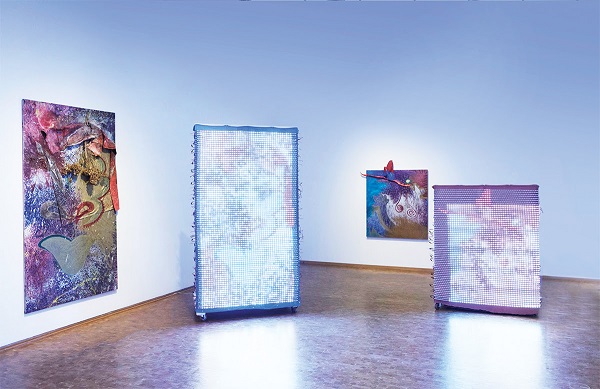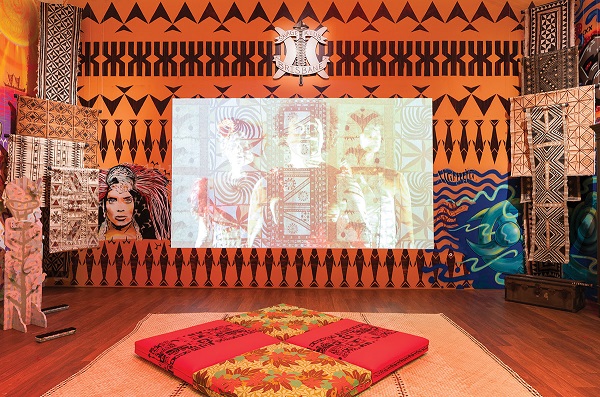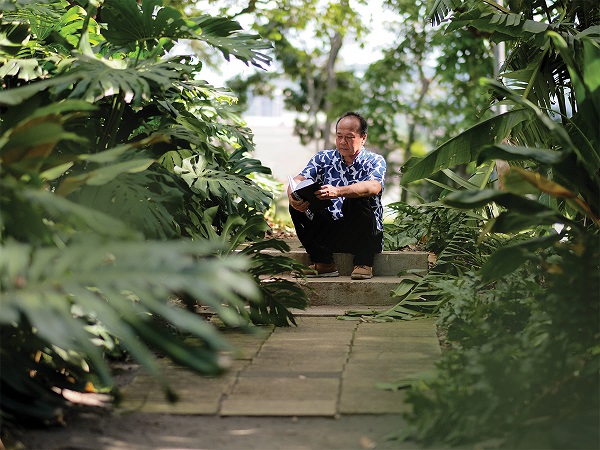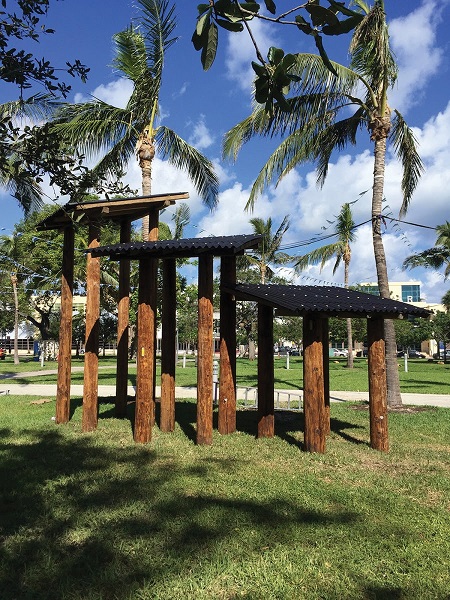Apart of naturalist, Landscaper and sculptor Leland Miyano (pictured, above) already lives at Foster Botanical Garden. Stones he shaped by hand sit on the lawn. This month, the artist invites volunteers to help build his next piece there—a 50-foot double-hull canoe created from truckloads of invasive plants and other found items from Ho‘omaluhia Botanical Garden. Through March 5, volunteers 6 years and older can join him to weave branches, twist ti leaf lei and work with leaves and other materials for “Huaka‘i | A Wake,” which will be showcased in the 2019 Honolulu Biennial.

EI ARAKAWA. COLOGNE OF THE MAGHREB (BODYPHILIA SONG), 2016
PHOTO: RHEINISCHES BILDARCHIV / EVA BAUER
Art about the Pacific created by those spiritually connected to the region is the theme of the second edition of the Honolulu Biennial To Make Wrong / Right / Now. Contrary to romanticized work from the past that simultaneously explored and exploited the “exotic” Pacific, all artwork in this two-month event is driven by the place it represents and created by 47 artists and artist groups from the Pacific (a third from Hawai‘i).
This year’s concept, which was pulled from a poem by participating kanaka maoli artist ‘Imaikalani Kalāhele, asks artists to explore the past, present and future of their Pacific identity, “not only to be correct but to be brave, to see beyond a new horizon but also take everything with you and that’s everything that defines a sense of place, your ancestral roots and your indigenous knowledge,” as co-curator Nina Tonga put it.
The citywide exhibition that opens March 8 is an opportunity to experience history being rewritten through the hands of indigenous artists expressed through everything from fiber to photographs, film and structures created from invasive plants.
Here is what you need to know about this urban immersive experience.

ROSANNA RAYMOND. SAVAGE K’LUB 2010–ONGOING
IMAGE: COURTESY OF QAGOMA. PHOTO: NATASHA HARTH
TAKE A PASS
The heart of the Biennial is The Hub, located at the former Famous Footwear at Ward Village, where you’ll find the most Biennial artworks in one place. The cost to get into The Hub ranges from $7 to $12. Visitors can also check out more than 10 other venues across O‘ahu, including the Honolulu Museum of Art, the John Young Museum of Art at UH Mānoa and Bishop Museum.
Many but not all of the exhibitions are free to the public, so those wishing to visit the art again and again can purchase all-access passes ($75), which grant unlimited entry for the duration of the Biennial. Otherwise, you can pay the respective admission fees as you go along.
RETHINK DOWNTOWN
Focusing on a sense of place, this year’s Biennial has artists telling the unique stories of O‘ahu neighborhoods—in particular, the downtown area for its historical importance. (It is home to some of Honolulu’s oldest buildings, after all.) Shed your old conceptions of downtown as a crowded place to just grab dim sum or do business and be reminded of its vibrant cultural significance by visiting first-time downtown Biennial venues, the 19th-century-built Ali‘iōlani Hale, YWCA Laniākea and the Hawai‘i State Art Museum. Wander through Chinatown and prepare to be hypnotized by the LED light artworks from Ei Arakawa scattered throughout the city center. Don’t forget to step inside SaVAge K’lub Headquarters, an installation from Rosanna Raymond that’s a play on the Samoan concept of vā, the active space where relationships are created and evolve. Like vā, this installation changes as the Biennial goes on.
PUT TOGETHER THE PIECES
Other pieces are spread out across sites. Two artists address the concept of houselessness in Hawai‘i in large artworks at multiple Biennial sites. Influenced by the buildings found in his hometown of Mexico City, Abraham Cruzvillegas’ sculptures represent life here in Hawai‘i, both indoors and out. Native Hawaiian artist Bernice Akamine presents Ku‘u One Hānau, an installation of striking Hawaiian flag tents. Go on a mini scavenger hunt to Bishop Museum, Foster Botanical Garden, HiSAM, the McCoy Pavilion and The Hub to view the commissions in their entirety.
ABRAHAM CRUZVILLEGAS. SELF RECONSTRUCTED ELLIPSIS, 2017
© ABRAHAM CRUZVILLEGAS, COURTESY KURIMANZUTTO, MEXICO CITY AND REGEN PROJECTS, LOS ANGELES. PHOTOGRAPHY BY SILVIA ROSA AND ART BASEL PHOTOGRAPHIC SERVICES
WATCH ART IN MOTION
Art isn’t always static. Digital media and live performances will energize The Hub. Leave behind your own reality and transport yourself—through various video installations—into the lives of different Pacific peoples to learn about the challenges they’re currently facing. Taloi Havini of the Hakö people will walk you through the history of mineral extraction in the Pacific with Habitatwhile DAKOgamay, aka siblings Martha and Jake Atienza, introduce the seafarers and fishermen from Bantayan Island who must adjust to climate change. Seoul-based artist group Young-Hae Chang Heavy Industries presents Pacific Limin, a poignant commentary on the hypercapitalism of Pan-Pacific cities against a jazz soundtrack.
Local community artists will also perform center stage on Tuesdays, Thursdays, Saturdays and Sundays. Acquaint yourself with organizations and art groups you never knew, performing right in your own backyard. Anyone using any medium could apply for a time slot, so from demonstrations to dances, expect the unexpected—and to leave feeling inspired. “We saw that need [for a performance space] and were like, ‘All right, let’s create a free open platform that people can come and perform,’” says Katherine Tuider, the Biennial’s co-founder.
FEEL THE WAHINE SPIRIT
This year, the curators celebrate female artists and collectives who are embracing their cultural traditions in a modern world, Tonga says. Florence Jaukae Kamel, a textile artist and women’s rights advocate from Papua New Guinea, is a master at making bilum, or hand-woven bags, and started a cooperative to help women use the art to earn money for health care. Kamel manipulates the looping and knotting technique to create large-scale installations and fashionable garments on display at The Hub and YWCA Laniākea. The HiSAM exhibit of Maori artist group Mata Aho Collective includes colossal fiber-based works inspired by the indigenous textile collections at the Bishop, Cambridge and British museums.
RESERVE YOUR SPOT
Don’t forget to buy tickets for the public programming, such as workshops and artist talks. During the last Biennial, these spaces filled up quickly. Tip: The price often includes free entry into The Hub.



